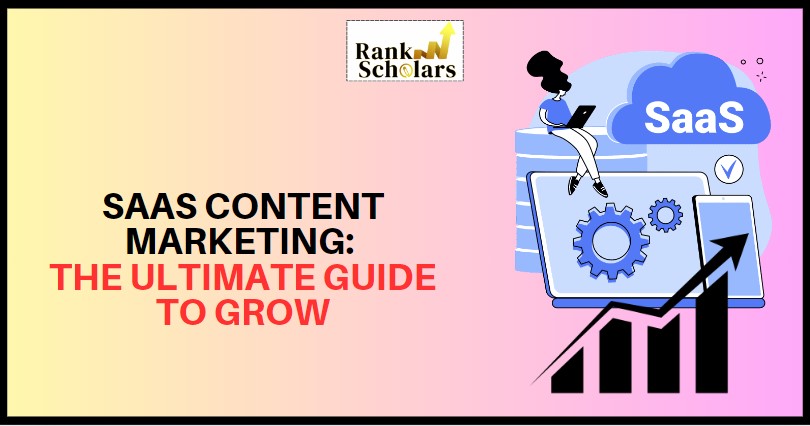When it comes to growing your SaaS business organically, content marketing is everything. Content Marketing positions you as an expert in the industry with an authoritative and credible voice.
According to Demand Metric, content marketing generates approximately 3 times more leads than traditional marketing and costs 62% less. A Gitnux report says that SaaS businesses that use content marketing report a lead generation growth of up to 400%. But what is SaaS Content Marketing and how is it done?
Following is a comprehensive guide that takes you through every aspect of SaaS content marketing in an easy way. Start your SaaS Content Marketing journey today!
What Is SaaS Content Marketing?
SaaS Content Marketing is a special type of marketing approach that is focused on catering to the marketing and promotional needs of Software as a Service(SaaS) products.
The main objective of SaaS Content Marketing is to maintain its set of existing customers and gain new customers through various types of content that are relevant, informative, and valuable to your target audience.
This content can be in various forms such as blog posts, infographics, social media posts, LinkedIn posts, whitepapers, case studies, and even e-books.
How Is Content Marketing For SaaS Companies Different?
Content Marketing for SaaS Companies is different with various unique aspects and fundamental differences from content marketing in other industries. Some of the main differences are discussed as follows.
Educational Focus
The focus of content related to SaaS brands is majorly on educating the target audience due to the complex nature of SaaS products. Understanding the functions and features of these products can be complicated for some people.

The content is focused on how the products would help in solving their specific problems and how they can be used effectively for the best results which might not be easily understood by beginners in the SaaS industry.
Longer Sales Cycle
The sales cycle of SaaS products is often longer as compared to any other consumer products. This type of marketing has to focus on every stage of the consumer journey, from awareness to decision.
The content marketing strategies of SaaS products cater to every stage of the consumer journey, from awareness to consideration to decision by providing relevant, informative, and valuable content related to each phase.
Subscription Model
Customer retention is the key to success in any type of SaaS service. Most of the SaaS companies rely on subscription models and to retain existing customers.
Most SaaS Content Marketing is based on maintaining the existing consumer base along with getting new customers. Hence, creating content that helps users in making the best of your products and highlighting the advanced features.
Thought Leadership
SaaS companies can position themselves as thought leaders in the industry by publishing quality content. This type of content can involve writing in-depth whitepapers, e-books, case studies, and webinars.
By addressing the pain points of your target audience, answering their queries, and offering practical solutions, companies can establish themselves as trustworthy and credible.
Technical Content
Content Marketing specialized in Software as a Service may require a higher degree of technical content and understanding. When targeting technical decision-makers like CTOs and developers, technical content is essential.
This would involve creating and publishing content that explains technical and complex knowledge in a clear and approachable way.
Customer Success and Community Building
Engaging content can encourage a sense of community among your audience. Given the importance of consumer retention in SaaS Content Marketing, it is important to build a community around the products.
Consumer forums, comment sections, feedback loops, and interactive content like webinars and Q&A sessions are some examples of content types that can help in building community and engaging existing customers.
Product Updates and Roadmaps
Most of the SaaS companies frequently update their products with new features and improvements. It might be difficult for the customers both existing and potential to keep up with the updates and their efficient uses.
SaaS Content Marketing helps keep the consumers updated about the new features and improvements, highlighting the benefits and letting the consumers know about their best use cases.
7 Benefits of SaaS Content Marketing
Have you ever observed that almost all active SaaS companies have an active blog page? With the help of blogs published, they try to educate their prospects and create awareness about their brands.
This is an essential part of SaaS marketing strategy and is called SaaS Content Marketing. But what are the benefits of SaaS content marketing? Let’s dig in!
Educates Users
One of the most important benefits of SaaS Content Marketing is that it helps in educating users. A major part of SaaS content and products are complex, and may not be easily understood by the target audience.
Therefore, marketers must tailor their content in a way that is understandable and approachable to the target audience, breaking down complex topics in easy-to-understand language.
Develops Brand Awareness
Another major benefit of SaaS Content Marketing is developing brand awareness among your target audience. With the help of various types of content published online, brands can create awareness.
With consistent SaaS Content Marketing efforts, companies can create a distinctive voice in the cluttered market and present their features and benefits as differentiators from others.
Improving SEO and Online Visibility
By publishing content that is SEO-optimized, companies can make their blogs rank higher on SERPs and hence result in better brand visibility. Improving the company’s SEO practices will have a positive impact on its online visibility.
With the help of SEO-optimized content, companies can reach a wider set of audience and increase their brand awareness among people, bringing more organic traffic to their websites as a result.
Establishes Credibility
Quality content on your website would position you as an industry expert and help establish the credibility of your company. When potential clients would see you as a credible source of knowledge, they are more likely to choose your services.
By publishing relevant content consistently that addresses the pain points of your audience and solves their queries, you can make your company an authoritative figure in the industry.
Improves Traffic
Increased brand awareness and visibility online would ultimately result in improved traffic on your website. With the help of SEO-optimized content, your company’s blogs can rank better in SERPs.
With better rankings and higher reach among the audience, you can increase organic traffic on your website. This increased traffic would lead to a significantly new number of leads and customers.
Cost-Effective Marketing Solution
SaaS Content Marketing is one of the most cost-effective marketing solutions as compared to traditional advertising solutions. While the time required to curate and create content may be more, it is a long-term solution.
Once content is created and published online, it can continue to generate leads and drive traffic without any kind of additional costs incurred. This can provide a long-term solution for your marketing efforts without a large amount of investment.
Product Updates and Features
With the help of SaaS Content Marketing, you can provide your audience with regular product updates and features. By publishing blogs and infographics about your upgrades and their use cases, you can keep your existing customers engaged and let potential customers know about the benefits.
This would help in gaining a new customer base and retaining the existing customers with comparatively less effort and generate higher ROI.
7 Steps To Craft An Effective SaaS Content Marketing Strategy
Crafting an effective SaaS content marketing strategy may not be the easiest task but is surely not a complex one. Following are 7 easy steps for you to establish your SAAS content marketing strategy that would drive you to desired results and help you in better engagement.
Research The Target Audience
Researching the target audience that you want to focus on is the basis for crafting an effective SaaS Content Marketing strategy. You can identify a clearly defined set of audiences on various criteria.

By categorizing audiences on the basis of their demographics, age, gender, income levels, and many other bases, you can create your own checklist tailored uniquely for your products and create buyer personas.
Analyze Pain Points
Once you have identified your target audience, it is time to analyze their pain points. Addressing their specific pain points, you can mold your content strategy tailored to your target audience’s preferences.
You can identify your target audience’s pain points by creating a customer journey map which would lay out the steps of your buyer’s experience as they shift from prospects to customers.
Choose Specific Keywords
At every step of your consumer’s journey, they may use some specific keywords to conduct their searches. It is important to identify these specific phrases in order to specifically tailor your content to their queries.
These identified keywords would allow you to curate content that addresses their needs at every stage in their buying journey and promote higher sales. This would also help in customer retention and engagement.
Determine Campaign Goals And Metrics
Before curating your content according to the researched keywords and optimizing your blogs for SEO, you need to determine your campaign goals and align them with your marketing strategy in order to get the best results.
Metrics and KPIs are important and standard for content marketing in any industry. Key metrics such as bounce rate, unique website visitors, repeat rate, and session duration can reveal key insights about your campaigns.
Create And Publish Content
After researching your target audience, and their pain points, searching for relevant keywords, and setting measurable campaign goals, it is now the time to create informative and helpful content.
To make your content creation process easier, it is important to set up a step-by-step breakup of the process which includes: topic research, keyword research, target audience research, content creation, content calendar, and campaign goals and metrics.
Define The Distribution Strategy
The distribution strategy defines how often and where you will publish the content created by you in order to drive the best possible results along with the strategies to promote the content.
Creating a distribution strategy would ensure that your content reaches the right audience. It would include the channels through which the content will be shared such as email newsletters, social media, and influencer partnerships.
Measure Campaign Performance
Measuring the campaign performance is one of the most significant steps to assess the effectiveness of your content strategy. Various KPIs like website traffic, engagement, and conversion rates are some metrics tracked.
After tracking your metrics, you can alter your content strategies based on data-driven insights in order to get the best possible results and better the strategies and techniques employed.
Recent post: How To Start A Content Marketing Agency In 2024 In 10 Steps
Content Refreshing And Repurposing For Existing SaaS Content
Content refreshing and repurposing are significant practices for increasing the lifespan of existing content. This would allow you to maximize the value of your content, increase its reach, and ensure that it remains relevant.
Content Refreshing
Content Refreshing means enhancing the existing content on your website to ensure its relevance, accuracy, and usefulness. This practice is significantly helpful in your SEO efforts and in keeping up with the industry trends.
Following are five easy steps by which you can start refreshing your content today!
Identify Content To Refresh
There are various analytics tools available to identify the content that gains high traffic but is outdated or has decreased performance over time.
You can search out the content that aligns with the industry trends, your recent product updates, or any recent updates in your business.
Analyze it for improvement opportunities
After scooping out the content that can be used again, check it for outdated information, broken links, and any major updates made during the time.
Analyze user feedback and comments to know about discrepancies and other improvements that can be made to make the content more informative and gain more traffic.
Update and Enhance Content
Once the analysis for the scope of improvement is done in the content, it is time to update and enhance it. Rather than rewriting the whole content piece, try to make the major changes.
Outdated information, broken links, and SEO elements like meta titles, meta descriptions, and keywords can be changed to improve visibility on SERPs. Add new data, statistics, images, and graphs to make the content more up-to-date and aligned with newer trends.
Add Internal Links
To drive more traffic toward your website and newer content, adding internal links to your content is one of the easiest and most cost-effective ways.
You can incorporate relevant internal links from your website to improve user experience and get more traffic on recent content pieces.
Republish and Promote
Once you have identified, analyzed, and updated the content that is to be refreshed, you can either republish it with a note about the updates or as a new publication.
You can promote this updated piece of content through email newsletters, social media, or other distribution channels to gain new visitors.
Content Repurposing
Content repurposing means taking the existing content and changing it into a new format in order to reach a wider set of audience. This practice helps in enhancing the quality of your content and drives more traffic.
With the help of content repurposing, you can reach new audiences without creating content from scratch. Following are 5 easy steps to get you started with content repurposing.
Identify Content to Repurpose:
Identify the high-performing content that can be adapted into different formats or can be used in new contexts or another way that is different from the previous. You can select content with a value that is useful throughout the years or addresses common pain points.
Choose Repurposing Formats:
Once you identify the content that can be repurposed into different formats and contents, it is time to choose the ideal repurposing format.
While choosing formats, it is important to select each format in accordance with their original forms. For example, turning podcasts into blog posts and blog posts into video tutorials.
Reimagine the Content for New Audience:
Reimagining the content for new audiences includes adapting the tone and style in accordance with the platform and audience.
You will customize the content’s format so that it fits the distribution channels, such as images for social media, videos for YouTube, and newsletters via emails.
Distribute and Promote:
To distribute and promote the repurposed content, you can share it across various social media platforms including social media, emails, and websites.
For higher reach and popularity, you can collaborate with influencers and industry experts which would in turn expand your reach.
Monitor Performance and Adjust:
After publishing the repurposed content, it is important to monitor its performance and other KPIs to measure the effectiveness of your campaign.
Based on the metrics and performance, you can adjust your strategies and techniques accordingly to attract new audiences.
5 Trends In SaaS Content Marketing
The SaaS industry is dynamic and has been constantly developing, with content marketing playing a significant role in driving visibility and growth. Following are five trends in SaaS content marketing that are emerging.
AI-Powered Content Tools
AI-powered content tools use machine learning algorithms to analyze the given data, generate useful insights, and automate various stages of content creation and marketing.

AI tools can be used to generate content based on user preferences and data inserted, analyze metrics and engagement, and optimize the content for better performance.
Predictive Analytics
Predictive analysis uses machine learning algorithms and data analysis techniques to predict future trends, consumer behavior, and results. Predictive analysis can help forecast consumer needs, personalize content, and optimize content strategies in the area of SaaS content marketing.

Key applications can include content recommendations, lead scoring, and churn prediction. Based on data analysis, they can predict the risk of churn and help companies imply personalized retention strategies.
Market Consolidation
A significant consolidation is visible in the SaaS industry as larger companies acquire the smaller ones in order to expand their services, enhance their products, and increase their market share.
Acquiring companies can integrate their content strategies, assets, and teams in order to create a cohesive content ecosystem. This ecosystem would have a wider range of audiences, resources, tools, and distribution channels.
API-Based Models
In the field of content marketing, API-based models help with data sharing, workflow automation, and personalizing experiences. These can ensure a hassle-free integration between different SaaS products and platforms.
APIs would allow your content to be associated with multiple platforms and websites which would increase reach and visibility while smoothing out workflows and enhancing data-driven decisions.
RevOps Integration
RevOps aims to provide organization and operational alignment across sales and marketing. This alignment is done to drive revenue growth and consumer satisfaction.
RevOps integration involves unified data metrics and performance goals across sales. It also helps in closed-loop reporting allowing teams to track the entire consumer journey from lead generation to conversion and retention.
Also Read: 20 Content Marketing Books to Make $$$$$
7 B2B SaaS Content Marketing: Key Considerations
Crafting a successful B2B SaaS content marketing strategy requires attention to some special aspects from the perspective of customers. From understanding the customer journey to delivering them personalized content, the following are 7 key considerations to make while creating a B2B SaaS Content Marketing strategy.
Understanding The Customer Journey
Understanding the customer journey and considerations they go through while buying a product, right from the awareness to purchase and beyond, lets you tailor specific content for them.
This would allow you to identify the pain points that consumers encounter and tailor content strategies accordingly, ensuring relevant and quality content. Constantly refining content based on the consumer journey would result in better engagement and conversion rates.
Creating Relevant Personalized Content
Creating content that is targeted to a specific set of audiences or individuals would significantly enhance the relevance of your content and its engagement rates. Data utilization plays an important role here.
Using the data of customers that you have acquired through various forms and leads, you can enhance their experience and have a better chance at conversions. Automated tools can ensure that the content delivered to your audience is highly personalized and targeted for every individual.
Nurturing Different Stakeholders
Identifying and understanding the different types of stakeholders involved in the process of buying is significant to delivering and catering to every group. This includes decision-makers, decision influencers, and the end-users.
Crafting content that speaks to each stakeholder individually is important to provide value to them at every stage of their journey. Using and blending different types of content formats is necessary to reach different types of audiences and convert leads.
Share Case Studies And Customer Success Stories
Sharing practical examples of how your SaaS products have helped the users drive tangible results and achieve their goals would help your potential customers understand your product better and its use cases.
Case studies and success stories with specific use cases, benefits of your product, and enhanced ROI can prove to be a deciding factor in your audience’s consumer journey. Ensure that the stories that you share focus more on the human elements and how your product has impacted individuals and organizations.
Add Informative Long-Form Content
Adding informative long-form content such as whitepapers, case studies, and ebooks would position you as a credible and authoritative figure in the industry. These guides can include various insights, in-depth analysis, and best practices to follow.
Long-form content can include informative content that addresses the queries and challenges faced by the audience. It can also contribute to your SEO efforts by attracting organic traffic and establishing authority.
Align Sales And Marketing
Encouraging alignment between sales and marketing teams is a means to ensure a smooth customer experience from initial contact to post-sales services. Aligning shared goals between the two would encourage better focus.
Sharing information and insights between the sales and marketing departments would allow you to have better-tailored marketing strategies and improved content creation that caters to different sets of audiences.
Promote Content Across Different Channels
Promoting your content across different channels can significantly enhance traffic and drive better engagement rates. Paid advertising and influencer partnerships will improve the reach of your content and gain a large audience.
Sharing your content across various channels would increase content exposure and drive audience engagement by getting them acquainted with relevant and informative content.
Achieve SaaS Content Marketing Success With Rank Scholars
Credible and well-optimized content is the key to your business’s success. Rank Scholars is one of the best content marketing agencies that helps you with personal branding, content marketing, and generating traffic that converts.
Rank Scholars specializes in working with B2C, D2C e-commerce, and B2B SaaS Content Marketing. The agency was founded by Aastha Kochar, a freelance blogger with over 6 years of experience. Check out some of the proven results here. We, at Rank Scholars provide you with a cost-effective solution for your SaaS content marketing needs with quality content and quick turnaround time.
Schedule a demo today!
Final Words
In conclusion, focusing on SaaS Content Marketing is significant for driving growth and establishing yourself as a credible and authoritative presence in the cluttered market. From understanding the consumer’s journey to delivering personalized content to them, each aspect plays an important role in engaging and guiding your prospects through the buyer’s journey.
By following this comprehensive guide, you can effectively engage your potential customers, build trust and credibility among them, and ultimately drive conversions.
Let’s start your SaaS Content Marketing journey today!

Anubhuti is a freelance writer who crafts engaging content. Running on a single cup of coffee, on most days, she prefers books and music over people and loves creating compelling content for you!



